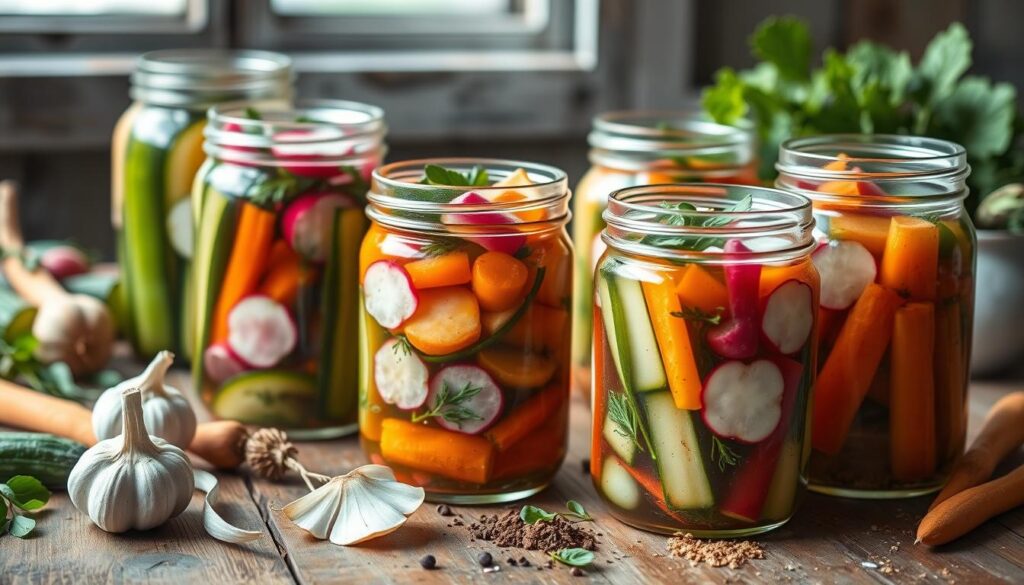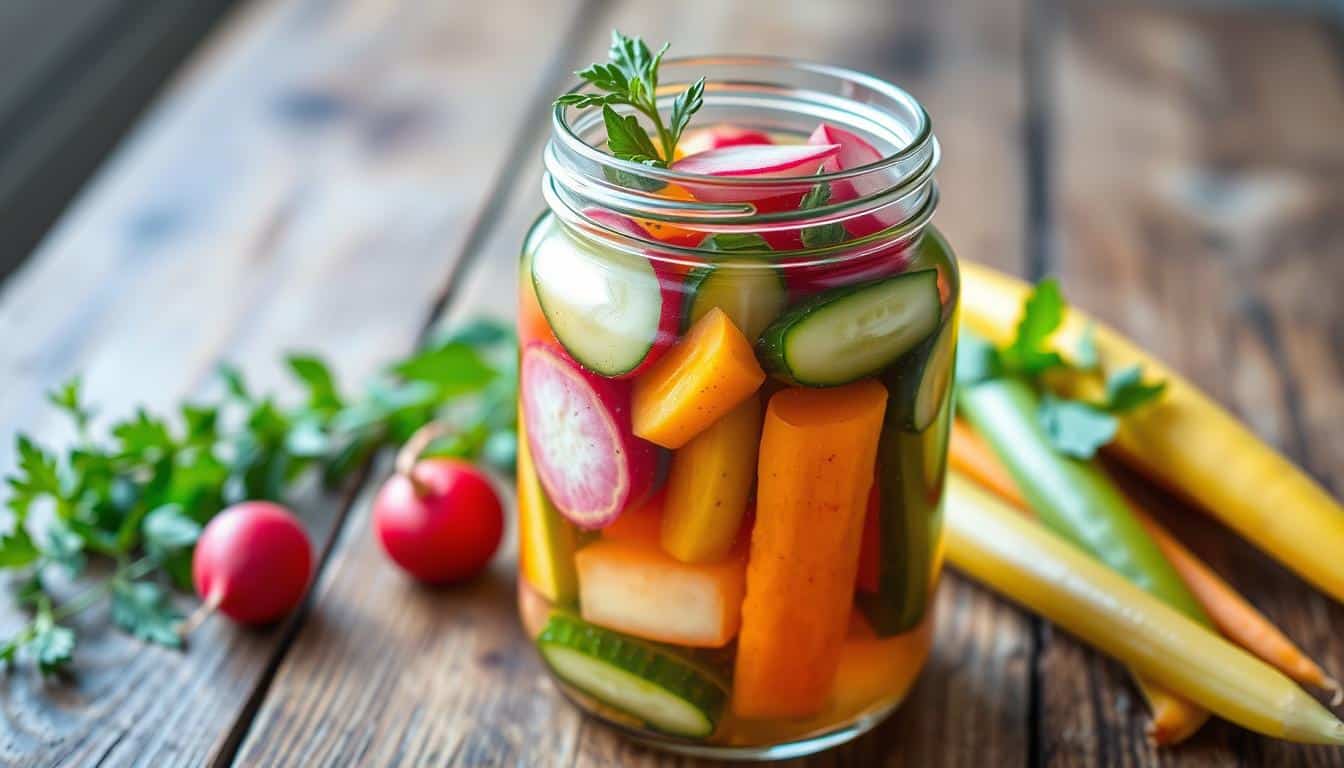I’m excited to share my love for Quick Pickled Vegetables. They’re a game-changer in the kitchen! These tasty treats add zing to your meals. With an easy recipe, you can make your own Quick Pickled Vegetables in no time. Let’s dive into the world of quick pickling!
I love serving Quick Pickled Vegetables with my favorite dishes. Like Ina Garten’s Parmesan Chicken, it’s a perfect match. You can also pair them with roasted broccoli or oven-roasted potatoes. The options are endless with Quick Pickled Vegetables and an easy recipe.
Key Takeaways
- Quick Pickled Vegetables for a Tangy Side are easy to make and require minimal effort.
- An easy pickling recipe can help you create delicious Quick Pickled Vegetables for a Tangy Side.
- Quick Pickled Vegetables for a Tangy Side are perfect for adding some zing to your meals.
- You can serve Quick Pickled Vegetables for a Tangy Side with a variety of dishes, such as Parmesan Chicken or roasted vegetables.
- Quick Pickled Vegetables for a Tangy Side are a great way to add some freshness and flavor to your meals.
What Are Quick Pickled Vegetables?
Quick pickled vegetables add a tasty crunch to your meals. They’re made by soaking fresh veggies in vinegar for a short time. This gives them a tangy taste and a crisp feel. I love adding these veggies to my dishes, and I’m eager to share some pickling tips with you.
Making quick pickled veggies is quick and easy, unlike traditional pickling. It’s perfect for those who want to enjoy pickled veggies fast, without waiting weeks.
Definition and Overview
Quick pickled veggies help keep your favorite veggies fresh and flavorful. You can use many veggies like cucumbers, carrots, and bell peppers. Season them with spices and herbs for a unique taste.
History of Pickling Techniques
Pickling has been around for thousands of years. It’s a way to preserve food and add flavor. The history of pickling is rich and varied, from ancient times to today.
Quick pickled veggies can make any dish more flavorful. They’re great in salads, sandwiches, or as a snack. Let’s dive into some pickling tips and recipes, and explore the world of quick pickled veggies!
| Vegetable | Pickling Time | Flavor |
|---|---|---|
| Cucumbers | 30 minutes | Sour and salty |
| Carrots | 1 hour | Sweet and tangy |
| Bell Peppers | 2 hours | Crunchy and sweet |
Benefits of Quick Pickling
Quick pickling keeps your favorite veggies fresh and full of nutrients. It’s easy to make a tasty brine that turns veggies into a healthy side dish. This method helps keep vitamins and minerals in the veggies, making them good for your diet.
I enjoy making quick pickled veggies because they’re so flexible. You can add them to salads, sandwiches, or even use them as a cocktail topping. They’re simple to make and keep well in the fridge for weeks, making them a handy snack.
Nutritional Advantages
Quick pickling is tasty and good for you. It keeps veggies’ natural flavors and nutrients, giving you a boost of vitamins and minerals. Plus, pickled veggies are full of probiotics, which are great for your gut health.
Preservation and Shelf Life
Quick pickling also helps you save money and reduce waste. It lets you keep seasonal veggies fresh for longer. This way, you can enjoy your favorite veggies all year, whether as a side dish or a quick snack.
- Preserves vitamins and minerals
- Retains natural flavors
- Rich in probiotics
- Extends shelf life
- Reduces food waste
Quick pickling is a smart way to enjoy veggies all year while supporting a healthy diet and cutting down on waste. So, why not try making your own pickled veggies today?
Choosing the Right Vegetables
When pickling for beginners, picking the right veggies is key. Start with crisp, fresh produce for the best taste. Cucumbers are classic, but try green beans, carrots, and bell peppers too.
Seasonal veggies can boost your pickle’s flavor. In summer, pickling zucchini or cherry tomatoes is great. In fall, beets or cauliflower are perfect. The choices are endless, making it super fun!
Here are some top picks for quick pickling:
- Green beans: They’re quick to pickle and taste amazing in just 30 minutes.
- Carrots: You can pickle them in sweet or spicy flavors. They’re perfect as a snack or side.
- Bell peppers: They add crunch and sweetness, making them a great pickle addition.
Remember, the secret to great pickles is to have fun and try new things. With a bit of practice, you’ll be making tasty quick pickles like a pro!
| Vegetable | Prep Time | Refrigeration Time | Total Time |
|---|---|---|---|
| Green beans | 10 minutes | 20 minutes | 30 minutes |
| Carrots | 10 minutes | 20 minutes | 30 minutes |
| Bell peppers | 10 minutes | 20 minutes | 30 minutes |
Essential Ingredients for Quick Pickling
Creating a tangy vegetable recipe starts with the right ingredients. For a tangy side, focus on a few key items. Vinegar is the main ingredient, and you can pick from many types. White vinegar offers a sharp taste, while apple cider vinegar adds a fruity hint.
Experimenting with vinegar types can lead to the perfect flavor. Rice vinegar and balsamic vinegar add depth to your dish. But vinegar isn’t the only thing that matters. Spices and seasonings like dill, garlic, crushed red pepper flakes, and honey can also change the taste.
Vinegar Varieties and Their Flavors
- White vinegar: clean, sharp tang
- Apple cider vinegar: subtle fruity note
- Rice vinegar: mild, slightly sweet flavor
- Balsamic vinegar: rich, complex flavor
Spices and Seasonings to Enhance Taste
Popular spices and seasonings for quick pickling include:
- Dill: classic pickling flavor
- Garlic: adds a pungent flavor
- Crushed red pepper flakes: adds heat
- Honey: adds a touch of sweetness

Quick pickling lets you adjust flavors easily. So, feel free to try new combinations and find your favorite pickle mix!
| Vinegar Type | Flavor Profile |
|---|---|
| White Vinegar | Sharp, tangy |
| Apple Cider Vinegar | Fruity, subtle |
| Rice Vinegar | Mild, slightly sweet |
| Balsamic Vinegar | Rich, complex |
Step-by-Step Guide to Quick Pickling
Now that we’ve covered the basics and benefits of quick pickling, it’s time to dive into the process. This easy pickling recipe will have you enjoying tangy, delicious pickles in no time. The key to a great pickle is in the preparation and the brine. Let’s start with the preparation of our vegetables.
For an easy pickling recipe, you can use a variety of vegetables like cucumbers, onions, and bell peppers. Wash them thoroughly and slice them into uniform pieces. This ensures they pickle evenly and look great in your jar.
Preparation of Vegetables
Once your vegetables are prepared, it’s time to make the pickling brine. This is where the magic happens, and your pickles start to take on that tangy flavor we all love. A basic pickling brine includes vinegar, water, salt, and sugar. You can adjust the proportions to taste, but a good starting point is 1 cup of vinegar to ¼ cup of water, with 1-2 tablespoons of sugar and salt.
Making the Pickling Brine
Combine your vinegar, water, sugar, and salt in a saucepan and heat it until the sugar and salt dissolve. Let it cool slightly before pouring it over your prepared vegetables. One of my favorite pickling tips is to add your spices directly to the jars before pouring in the brine. This helps infuse the flavors more deeply into your pickles.
With these simple steps and pickling tips, you’re well on your way to creating your own delicious, quick pickles. Remember, the key to a great easy pickling recipe is in the balance of flavors and the preparation of your vegetables. Experiment with different vinegars and spices to find the combination that works best for you.
Creative Combinations for Tangy Flavors
Exploring different flavors in quick pickles is fun! I enjoy mixing things up to make a tangy side dish. A favorite of mine is cucumbers with dill and garlic. But why not try pickling carrots with ginger and turmeric for a spicy twist? Or, how about pickled red onions with a touch of star anise? The goal is to have fun and trust your taste buds.
Adding fruits to your pickles can elevate them. A few slices of lemon or lime can brighten any jar. I once pickled watermelon rinds with cinnamon and cloves, and it was amazing! The sweetness of the watermelon worked well with the tangy pickling liquid. Here are some other unique combinations to try:
- Pickled cauliflower with raisins and pine nuts for a sweet and savory mix
- Pickled beets with orange zest and walnuts for a pop of color and flavor
- Pickled green beans with lemon and garlic for a classic summer side dish

Remember, the most important thing is to experiment and find the combinations that you enjoy the most. With a little creativity, you can create a tangy side dish that’s sure to impress your friends and family. So don’t be afraid to think outside the box and try something new – your taste buds will thank you!
| Vegetable | Pairing | Flavor Profile |
|---|---|---|
| Cucumbers | Dill and garlic | Classic, refreshing |
| Carrots | Ginger and turmeric | Spicy, vibrant |
| Red onions | Star anise | Sweet, savory |
Cooking Tips for the Best Results
When pickling for beginners, it’s key to follow some basic tips. The right type of salt is crucial. Pickling salt is better than table salt because it prevents your pickles from becoming too salty or cloudy.
Another mistake is not letting the brine cool before adding it to your veggies. Hot brine can make your pickles soggy. We want them to be crunchy! So, let the brine cool to room temperature before using it.
Here are some more tips to remember:
- Always use clean, sterilized jars to store your pickles.
- Make sure your pickles are fully submerged in the brine to prevent spoilage.
- Keep your pickles in the fridge to maintain their crunch and flavor.
By following these simple tips, you’ll make delicious homemade pickled veggies. They’re great for snacking or adding to your favorite dishes. Remember to be patient and let your pickles marinate for at least 24 hours. This allows the flavors to fully develop.
With these tips and a bit of practice, you’ll soon be a pro at making homemade pickled veggies. So, go ahead, try pickling, and enjoy the tasty results.
| Tips for Pickling | Benefits |
|---|---|
| Use pickling salt | Prevents over-salting and cloudiness |
| Let brine cool | Prevents pickles from becoming soggy |
| Use clean, sterilized jars | Prevents spoilage and maintains flavor |
Serving Suggestions for Quick Pickled Vegetables
Now it’s time to enjoy your delicious Quick Pickled Vegetables for a Tangy Side! I love serving them alongside grilled meats or burgers for a fresh, zesty contrast. You can also try tossing some pickled red onions into your next Greek salad for a flavor explosion!
For a quick and easy snack, use your pickled veggies as a fancy garnish for cocktails, like a pickled green bean in a Bloody Mary. Create a grazing board with an assortment of your homemade pickles for your next barbecue or party – it’s sure to be a hit.
Some other ideas for using your Quick Pickled Vegetables include:
- Adding them to sandwiches and wraps for a burst of flavor
- Using them as a topping for tacos or salads
- Serving them as a side dish at barbecues or picnics

Remember, this tangy vegetable recipe is all about adding a pop of flavor to your meals, so get creative and have fun with it! With these Quick Pickled Vegetables for a Tangy Side, you’ll be sure to impress your friends and family with your culinary skills.
| Recipe | Ingredients | Serving Suggestions |
|---|---|---|
| Quick Pickled Vegetables | Vegetables, vinegar, spices | Grilled meats, burgers, salads, sandwiches |
How to Adjust the Tanginess
Finding the right mix of sweet and sour is crucial for quick and tangy vegetables. I enjoy trying out different flavors to make tasty quick pickles. To change the tanginess, you can adjust the sugar and vinegar in your brine. For a sweeter pickle, add more honey or sugar to balance the acidity.
If you prefer a tangier pickle, up the vinegar or add lemon or lime juice. Making quick pickles at home lets you control the flavor. So, feel free to experiment and find what you like best.
- Start with a basic brine recipe and adjust the amount of sugar and vinegar to taste.
- Experiment with different types of vinegar, such as apple cider or white wine vinegar, for unique flavor profiles.
- Add a bit of spice, such as red pepper flakes or mustard seeds, to give your pickles an extra kick.
The secret to great quick pickles is tasting and adjusting as you go. Don’t hesitate to try new flavors and combinations. With practice, you’ll soon be making delicious quick pickles like a pro!
| Ingredient | Quantity | Adjustment |
|---|---|---|
| Sugar | 1-2 tablespoons | Adjust to balance sweetness and tanginess |
| Vinegar | 1-2 cups | Adjust to increase or decrease tanginess |
| Citrus juice | 1-2 tablespoons | Adjust to add brightness and acidity |
FAQ
Q: What is the best easy pickling recipe for homemade pickled veggies?
A: The best easy pickling recipe for homemade pickled veggies is a simple vinegar-based brine. It involves mixing vinegar, water, salt, and spices in a saucepan. Bring the mixture to a boil, then pour it over sliced or chopped veggies in a jar. Let it sit in the fridge for a few hours or overnight to allow the flavors to meld.
Q: What are some easy pickling recipes for beginners?
A: Some easy pickling recipes for beginners include pickling cucumbers, carrots, and bell peppers. These recipes typically involve slicing or chopping the veggies, creating a brine with vinegar, water, salt, and spices, and then letting them sit in the fridge for a few hours or overnight.
Q: How do I make homemade pickled veggies?
A: To make homemade pickled veggies, start by selecting your favorite vegetables, such as cucumbers, carrots, or bell peppers. Slice or chop them into desired shapes. Next, create a brine by mixing vinegar, water, salt, and spices in a saucepan. Bring the mixture to a boil, then pour it over the veggies in a jar. Let it sit in the fridge for a few hours or overnight to allow the flavors to meld.
Q: What are some easy pickling recipes for beginners?
A: Some easy pickling recipes for beginners include pickling cucumbers, carrots, and bell peppers. These recipes typically involve slicing or chopping the veggies, creating a brine with vinegar, water, salt, and spices, and then letting them sit in the fridge for a few hours or overnight.
Q: How do I make homemade pickled veggies?
A: To make homemade pickled veggies, start by selecting your favorite vegetables, such as cucumbers, carrots, or bell peppers. Slice or chop them into desired shapes. Next, create a brine by mixing vinegar, water, salt, and spices in a saucepan. Bring the mixture to a boil, then pour it over the veggies in a jar. Let it sit in the fridge for a few hours or overnight to allow the flavors to meld.
Q: What are some easy pickling recipes for beginners?
A: Some easy pickling recipes for beginners include pickling cucumbers, carrots, and bell peppers. These recipes typically involve slicing or chopping the veggies, creating a brine with vinegar, water, salt, and spices, and then letting them sit in the fridge for a few hours or overnight.
Q: How do I make homemade pickled veggies?
A: To make homemade pickled veggies, start by selecting your favorite vegetables, such as cucumbers, carrots, or bell peppers. Slice or chop them into desired shapes. Next, create a brine by mixing vinegar, water, salt, and spices in a saucepan. Bring the mixture to a boil, then pour it over the veggies in a jar. Let it sit in the fridge for a few hours or overnight to allow the flavors to meld.

